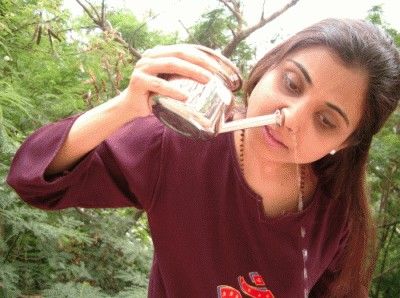
3 Ayurvedic Cleansing Techniques You Can Start Using Today
3 Ayurvedic Cleansing Techniques to Implement Today
Ayurveda is the ancient Indian science of life that has been used for over 4000 years. Here are three simple Ayurvedic cleansing techniques that you can begin today. These techniques may seem odd or complex, but once learned, they are easy to understand and execute. These three Ayurvedic cleansing techniques are the basic tenants of daily Ayurvedic hygiene.
1. Ayurvedic Tongue Scraping
If you thought brushing your teeth in the morning & evening was sufficient for oral health, think again. Tongue scraping is the perfect supplement to flossing and teeth brushing. Tongue scraping is one of the most efficient Ayurvedic cleansing techniques. Tongue scraping is basic and easy, yet so important.
The tongue plays crucial roles in healthy body functioning. As you sleep each night, toxins accumulate on your tongue. Every morning, as soon as you wake up (before brushing your teeth), use your tongue scraper to remove the layer of toxins.
Depending on the individual, Ayurveda recommends recommends a copper, gold, or silver tongue scraper.
For beginners, you can simply start with a stainless steel tongue scraper or even a plastic tongue scraper from your local pharmacy or grocery market.
As an added benefit, removing the phlegm from your tongue each day will improve your breath. 😉
2. Ayurvedic Oil Pulling
Ayurvedic oil pulling is a terrific way to cleanse your mouth. Through consistent oil pulling, your teeth, tongue, and gums will be cleansed. Oil pulling is one of the more simple, inexpensive, ancient Ayurvedic cleansing techniques. Oil pulling will cleanse your mouth in ways that brushing your teeth does not.
To oil pull, bring a spoonful of vegetable or coconut oil to your mouth and use it as you would mouthwash. Gargle the oil for fifteen to twenty minutes. Spit the oil out (not in sink because it can cause clogs in drains) and brush your teeth immediately after to rid your mouth of toxins.
Warning: Do not swallow the oil! The oil is full of toxins after swishing around in your mouth for twenty minutes.
Check out our post here on the Benefits of Oil Pulling.
3. Ayurvedic Neti Pot Cleansing
Some of the benefits of Ayurvedic Neti Pot Cleaning include:
- Flushing of harmful matter (i.e. dirt, dust, bacteria, etc.)
- Increase in the flow of prana (energy)
- Improved breathing
- Improved sense of hearing
- Natural alternative to sinus medication
How to start using a Neti Pot:
Purchase a neti pot from an Ayurvedic store or even your local pharmacy. Fill the neti pot to the correct level with warm water (after it has boiled and cooled) and pharmaceutical grade salt.
Put the spout of the neti pot in your nostril and lean your head slightly forward. Tilt your head to a 45 degree angle. This will ensure that gravity will assist and your nasal passage will be cleansed with ease. The water enters in one nostril and out the other. As soon as the water is gone, refill the neti pot with water and salt and repeat on the opposite nostril.
Neti pot cleansing should be practiced with care and meticulous attention. It can be dangerous otherwise.
Advice for using neti pot effectively:
- Use 100% sea salt or pharmaceutical grade salt that has been manufactured specifically for Ayurvedic Neti Pot Cleansing.
- Use filtered water. Warning: Do not use tap water for Neti Pot cleansing. Tap water may contain trace contaminants that can cause significant harm. Use Distilled water and boil it.
- Clean your neti pot with hot, filtered water after each usage. Dry your neti pot with a paper towel and store in a dry, cool, dark place.
- Do not cover one nostril and blow nose
- The water should be warm but comfortable, you don’t want to burn your nasal passage.
- The ratio between water and salt is also important. Do not use use too much or too little salt.
Note: I have recently implemented Neti Pot cleansing as a tool to improve athletic performance. Before every basketball game, I cleanse my nasal passage with my Neti Pot. The results have been great as I can breathe so much easier. My stamina has increased tenfold.
Here is our preferred Neti Pot.
We hope you implement these Ayurvedic Cleansing Techniques to feel more alive, well, healthy, and lucid.
What is your experience in using these (or other) Ayurvedic Cleansing Techniques?

Well, first well written, very nice. I would add that beginners who don’t have a tongue scraper, may use a stainless steel teaspoon and scrape the tongue easy, not with force.
About the Neti, as far as I know it is more a Yogic technique than an Ayurvedic one. Ayurveda has a cleaning for the nose called Nasya, it differs a bit from Neti. In Nasya, one inhales oil (medicated) or ghee into the nostrils and lubricates them as well, this way it keeps the airways clean and lubricated, breath comes easier and better. Nasya is a part of Panchakarma.
Joe,
Thank you so much for the comment.
This morning Danielle emailed me explaining that she hasn’t been able to find a tongue scraper anywhere (she’s living in China). I will send this tip over to her, great timing 🙂
Interesting, I didn’t realize that Neti is technically not an Ayurvedic practice, it is more yogic.
Any other Ayurvedic cleansing tips for beginners?
Thank you again 🙂
~Paz
Pingback: simpleNewz - Lucid Practice RSS Feed for 2014-12-07
I am happy to assist in whatever I can Paz.
About few more ways of cleansing in Ayurveda. The first will be of course Triphala. Triphala is a Sanskrit word meaning three fruits. The 3 fruits it stands for: Amalaki, Bibhitaki, Haritaki. This formula is a formula to cleanse the intestines off toxins. For maintenance, one may take 1 teaspoon in water before sleep, it will create a bowel movement in the morning.
Second, will be of course diet. Eat when you are hungry, and drink when you are thirsty, this will help cleanse the system easily and efficiently. Try to consume all the 6 tastes in every meal. Don’t overeat, eat as much as you are feeling hungry for. See my post on incorrect food combinations: http://wp.me/p35cMr-6b
A good way to help cleanse the system as well, is few days of Kichadi. A good recipe for Kichadi can be found here: http://www.ayurveda.com/online_resource/kitchari_recipe.html
At last, have a good routine, go to sleep around 10 PM and wake up around 6 AM. At around midnight the liver cleanses itself, so it is important to be fully asleep at that time. Waking up early, practising Yoga and Surya Namaskar is a good way to start the day, and thank Nature for Her grace. That way, your day will start fresh and you will feel no fatigue during the day.
That is just few things everyone can do for a better life and a better healthy living.